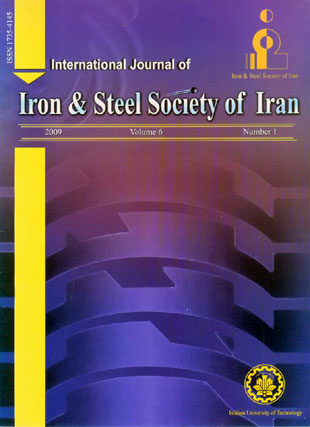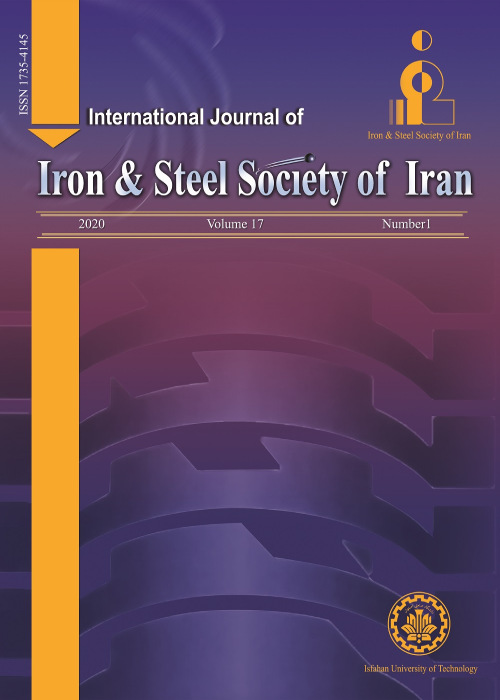فهرست مطالب

International Journal of iron and steel society of Iran
Volume:6 Issue: 1, Winter and Spring 2009
- 40 صفحه،
- تاریخ انتشار: 1389/08/10
- تعداد عناوین: 7
-
-
Page 1The continuous improvement of EAF performance is crucial for the increase in productivity and cost effectiveness and to render an environmental friendly process. RHI supports these targets by providing a diverse range of refractory and process solutions. Chemical energy in practical operation by injection of gaseous media like oxygen and natural gas, and solid materials like carbon have become a state of the art solutions for process improvement today. To understand the phenomena of the benefits, RHI has developed a mass and energy balance model. The objective of the model is to focus on the replacement ratio of electrical energy by chemical energy and the consequences for the overall CO2 emission of the process. CO2 emission certificate trading can become a new source for cash generation to be utilized for improvement investment budgets.Another valuable solution to decrease the energy consumption and the CO2 generation of the process is bottom purging in EAF. This technology can be introduced by the use of the directional porosity plug (DPP). The benefit of stirring in the furnace is that it enhances the interface reactions between the slag and the bath and homogenizes the liquid volume in the furnace. This results in achieving better operation parameters in terms of less power consumption and power-on time. Again a benefit in cost and a reduction in carbon dioxide emissions can obviously be attained.This paper shows the savings potential of the replacement of electrical energy by chemical energy by using the mentioned balance model. The benefit of the introduction of the DPP system is shown on the results of various steel plants.
-
Page 9In this research, possible usage of EAF dust on cement is investigated. Therefore, effects of addition of different percentages of EAF dust on the most important properties of cement such as hydration heat, water coefficient, viscosity, initial and final setting times, strength development and leachability of heavy metals were studied. Results showed that EAF dust alters the characteristics of cement unfavorably. So, it cannot be used for construction purposes. However, a prior soaking of EAF dust in water eliminates alkaline compounds which causes unfavorable alternation of cement characteristics and hence, engineering properties of the mixtures enhance especially long term strength of hardened mixtures. Leaching tests also proved that heavy metals contents of the leachates are considerably below the nonhazardous leachates limits. The above results document the perspectives of soaked EAFD solidification, disposal and the use of this waste material as a new additive to building materials.
-
Page 14Color metallography is a useful method for characterizing microstructures of steels with multiple phases. In this paper, application of three different color etching techniques for a bainitic-martensitic steel is reported. Comparisons between the results showed that 10% Na2S2O5 aqueous solution was the best etchant for distinguishing martensite, bainite and ferrite phases. The obtained micrographs were clear and sharp. Nanoindentation test was also carried out in order to approve the results of color metallography.
-
Page 19In the present work the effects of plasma nitridization on the passivation behavior of AISI 316L was investigated. To do this; nitriding treatments were carried out at 420°C for 1, 2, 4 and 16 hours. The phase composition and structure of the nitrided layer were studied by Low Angle X-ray diffraction and Scanning Electron Microscopy. The hardness of samples also was evaluated by Vickers microhardness test method. Potentiodynamic Polarization Scan (PDS) and Electrochemical Impedance Spectroscopy (EIS) techniques were used for corrosion studies. The plasma nitridization process produced surface-modified layers essentially composed of a metastable phase called S-phase, for all the nitrided samples, independent of the nitriding time. Surface microhardness measurements revealed that the surface hardness of treated samples was higher compared to that in untreated samples and that it increased with the treatment time. Electrochemical tests demonstrated that plasma nitriding for 4 h is the optimum treatment condition regarding corrosion behavior of nitrided austenitic stainless steels. In addition, nitriding treatment increases passivation current values and decreases charge transfer resistance value of the passive film.
-
Page 25In hot dip galvanizing, several parameters such as chemical composition of coating bath, immersion time and surface roughness of specimens could affect microstructure and properties of coating. In this article, the effect of aluminum content, immersion time and surface roughness on structure and properties of alloy layers have been investigated. Specimens of low carbon silicon-free steel with different surface roughness were galvanized in pure zinc bath and bath containing various amounts of aluminum for different times. It was found that the morphology of deposits was changed from layered to columnar state when 0.025wt%Al was added into coating bath. By increasing Al content up to 0.05wt%Al the adherence of the layers was improved but these thicknesses were decreased due to reduction of diffusion rate.
-
Page 30In this study, the changes in microstructure of HP-Nb cast heat resistant steel after 8 years of service at high temperatures were investigated. Study of microstructure using optical microscopy (OM) and scanning electron microscopy (SEM) equipped with an energy dispersive spectrometry (EDS) showed that the microstructure of this steel in as-cast condition includes an austenitic matrix, and that continuous eutectic-type precipitates in grain boundaries. These deposits include M23C6 chromium carbide and NbC. Aged sample microstructure at intermediate temperature (700-900 °C) consists of an austenitic matrix, M23C6 chromium carbides and blocky G-phase. The reason for this microstructure is the instability of NbC during aging at medium temperature 700-1000 °C which, as a partially phase transformation, is transformed to G-phase. But in the samples aged at higher temperatures (1000-1100 °C), there are only two types of NbC and agglomerated M23C6 carbide precipitations, and the skeletal morphology of NbC carbides has become spherical.
-
Page 34Aqueous polymer quenchants are being used increasingly in steel heat treatment industries as a substitution for conventional quenchants. By adjusting the quench parameters of the polymeric media, it is possible to achieve desirable microstructure and mechanical properties in addition to reduction in distortion and cracking. In this work, Polyalkylene Glycol (PAG) aqueous solution was used as the quenching medium in the heat treatment of four grades of steels produced by Iran Alloy Steel Company including 1.7227, 1.6582, 1.1191 and 1.7765. In addition, the resultant mechanical properties of this procedure were compared with the properties of the specimens quenched in the conventional quenchants. The results showed that using polymer-based quenchants, the distortion and cracking can be minimized compared to water quenching. On the other hand, the mechanical properties which are not achievable by oil quenching can be obtained using polymeric quench medium.


